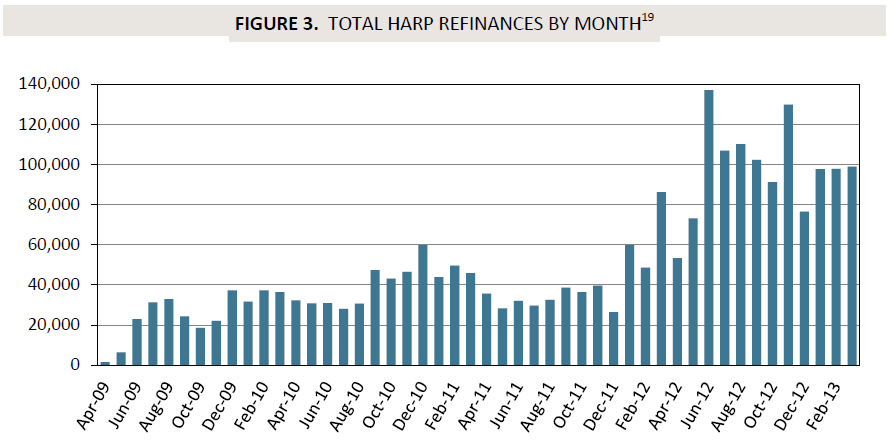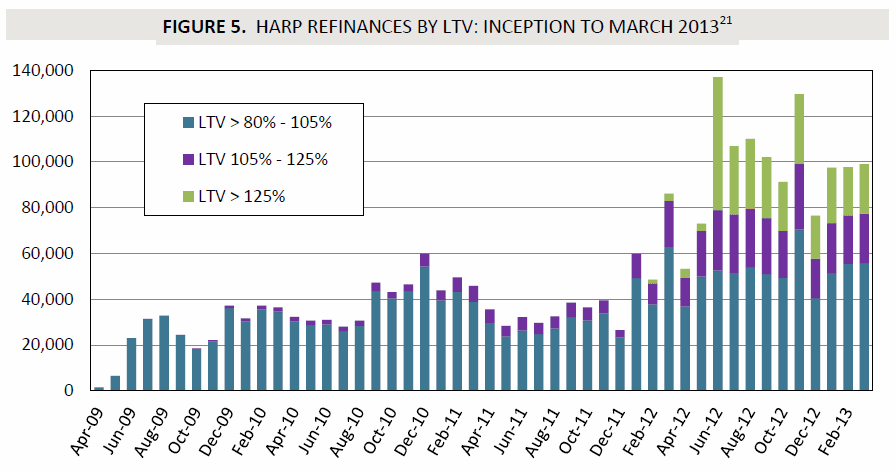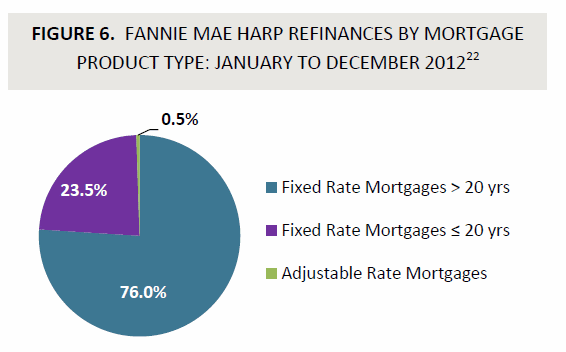The Office of Inspector General (OIG) of the Federal Housing Finance Agency (FHFA) has published an assessment of the Home Affordable Refinance Program (HARP) at what is presumed to be the midpoint of its existence. HARP was designed to assist borrowers with existing mortgages owned or guaranteed by Freddie Mac or Fannie Mae (the GSEs) to refinance even where they had little or no equity, were underwater, in their homes.
HARP began in March 2009, a joint project of FHFA and the Treasury Department. To qualify for the program under the guidelines for what is now called HARP 1.0, a borrower had to be current on their monthly mortgage payments and have a loan-to-value (LTV) ration of 105 percent or less (raised to 125 percent in the early days of the program.)
When HARP 1.0 was announced it was anticipated that four to five million borrowers were eligible to refinance under the program, however by September 2011 less than 1 million homeowners had done so. FHFA, the GSEs, lenders, and other stakeholders identified several issues with the program believed to be causing the lackluster results:
-
Loans with LTVs greater than 125% were not eligible for HARP 1.0 refinances;
-
The short program duration of approximately 15 months discouraged lenders from investing resources to market and originate HARP loans;
-
Representation and warranty liability deterred lender originations;
-
Manual property appraisals were required for the majority of originations;
-
Lenders were not permitted to solicit directly HARP-eligible borrowers for refinancing; and
-
Risk-based fees increased up-front borrower costs and diminished the benefit of a lower interest rate.
FHFA directed the Enterprises to collaborate with stakeholders to address these concerns and improve the program. After several modifications were agreed upon, FHFA publicly announced them in October 2011, rebranding the program as HARP 2.0. Changes included removing the 125 percent LTV ceiling, extending the duration of HARP by 18 months, eliminating the requirement for a manual property appraisal, lowering the maximum amount of risk based fees and revising lender solicitation guidelines, and allowing lenders to offer incentives to borrowers. Later modifications to the program included substantial representation and warranty relief for lenders and reduced documentation requirements. FHFA also extended HARP an additional two years, through December 31, 2015.
As a result of the program modifications creating HARP 2.0 and the subsequent changes, refinance volume has substantially increased. As of March 2013 2.4 million HARP refinances had been completed.

OIG said that the savings realized by borrowers each month through the HARP refinance is an important outcome. By lowering the monthly payment HARP reduces the risk of future default and potentially stimulates the economy. According to Fannie Mae's 2012 data, HARP borrowers saved an average of $250 per month or $3,000 per year.
Another outcome is the effect HARP has had on high-LTV loans. As lenders began to implement the HARP 2.0 changes in early 2012, finance volume for loans with LTVs between 105 percent and 125 percent began to increase. Then in June 2012 the GSEs permitted lenders to include HARP loans with LTVs greater than 125 percent into special mortgage-backed securities (MBS) and refinance volume for these loans dramatically increased.

HARP was also designed to place borrowers in more stable mortgage and over 75 percent of HARP borrowers refinanced into fixed rate mortgages with terms greater than 20 years while less than 1 percent refinanced into less stable adjustable rate mortgages. Further, a significant percentage of borrowers chose to refinance into shorter term mortgages which allow them to more quickly build equity in their homes.

Another important dimension for HARP is the impact it has had on the GSEs. OIG looked at the financial impact on them as a function of five variables, credit risk, guarantee fees, retained portfolio investments, representation and warranty relief, and opportunity cost. Some of these variables were found to be positive for the GSEs finances, some negative or neutral.
The credit risk associated with a HARP loan is intuitively lower than that of its original counterpart because the new mortgage has, at minimum, a lower interest rate, a lower payment, or a shorter amortization period than the original and may also have been refinanced into a more stable product. These conditions mean the GSEs are likely to benefit from HARP.
Likewise, guarantee fees are higher today than prior to 2009 and when a pre-2009 loan is refinanced the GSEs are released from the earlier g-fee structure and can securitize the refinanced loan and charge today's higher g-fee.
HARP refinances negatively impact the GSEs' retained portfolios because when HARP eligible loans are refinanced (pre-paid) the GSEs no longer receive interest payments on the original loan but purchase or guarantee a loan with a lower interest rates and thus less value. The effective cost to the GSEs is the difference in value from the net interest rate spread between the original loans and the new loans.
The cost of representation and warranty relief is neutral. The waiver of significant representation and warranty protection mandated by HARP 2.0 may negatively impact the GSEs, however the loans are seasoned loans made to borrowers with demonstrated ability to repay so the actual cost of eliminating the representations and warranties is mitigated by the loan characteristics.
Opportunity costs are foregone because there is no need for HARP eligible borrowers to acquire additional mortgage insurance or add equity to their loans. Thus because HARP exists, the GSEs forgo the opportunity to reduce their credit risk through enhancements or relieve themselves of the loan entirely.
OIG further assessed HARP by looking at FHFA's administration of the program, analyzing performance data and program outcomes, and identifying remaining program barriers. It found that FHFA's administration of HARP had included its active engagement of stakeholders to identify and address program problems including meeting with lenders, the GSEs, and mortgage insurers. To identify issues confronting borrowers Fannie Mae conducted a comprehensive survey of HARP-eligible borrowers in 2012 and the results of this survey was shared with FHFA.
These meetings with stakeholders resulted in the identification and implementation of a number of improvements such as the level of document required, aligning of same servicer and new lender requirements to enhance competition for borrower business, issues with representations and warranties, and aligning GSE requirements.
OIG also noted that FHFA had sought to increase HARP volume by pursuing state-level support for the program - working with state housing finance agencies that receive funds from the Treasury's Hardest Hit Fund.
OIG found that many of the barriers that earlier kept HARP from attaining its goals have been substantially mitigated but there are still some issues remaining related to borrower knowledge and understanding of the program, origination and closing fees, lender placed mortgage insurance, and lender capacity constraints. To address the borrower knowledge issues, FHFA has announced a nationwide public relations campaign to educate borrowers about HARP. The campaign is specifically intended to address the borrower misconceptions identified in the Fannie Mae borrower survey such as believing they are not eligible for the program or that they have to use an unfamiliar lender.
OIG concludes that, with over two years left in the program, it is difficult to project how many HARP-eligible loans ultimately will be refinanced because, among other factors, educating borrowers and encouraging their participation continue to be major challenges.







